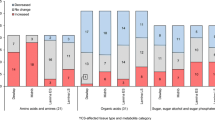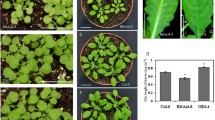Abstract
It is commonly accepted that sugars directly or indirectly modulate the expression of genes involved in photosynthesis, storage functions and defense. Generally, studies on gene expression made use of experimental systems where sugars were supplied from the outside of cells such as in protoplasts, cell suspension cultures etc.
Using sugar-accumulating transgenic tobacco plants which express yeast invertase either in the cytosol, vacuole or cell wall (cytlnv, vaclnv, cwlnv) we aim at distinguishing between intracellular and extracellular events of hexose sensing leading to altered gene expression. Invertase activity in the apoplast or vacuole but not in the cytosol leads to the repression of photosynthetic genes and to induction of some PR-protein genes. The induction of these PR-protein genes can equally be achieved by treating leaves of wildtype tobacco plants with sugar solutions. The sugar-mediated accumulation of PR-protein transcripts has been found to be dependent on leaf maturity and to occur independent from salicylic acid.
On the other hand, a separate set of genes has been observed to be up-regulated in cytlnv plants. By differential hybridization of a cytinv cDNA library five different cDNAs were isolated. By sequence analysis two cDNAs (cyt7 and cyt28) could be identified as plastidic aldolase and water stress related intrinsic membrane protein (PIP), respectively, One clone (cyt26) was highly homologous to S-adenosyl-methionine decarboxylase from potato, the key enzyme in polyamine biosynthesis. Cyt22 showed 71% homology toArabidopsis lycopene epsilon cyclase, the crucial enzyme in α-carotene biosynthesis, and cyt19 had 60% homology to tomato 1-aminocyclopropane-1-carboxylate oxidase homolog. Obviously, there are principal differences between sensing of and adaptation to sugars between intracellularly and extracellularly formed hexoses leading to diverse patterns of gene expression.
An inverse correlation between photosynthetic gene and PR-protein gene expression has not only be observed in cwlnv and vaclnv plants, but also in an interaction between wildtype tobacco plants and potato virus Y. The expression pattern of this interaction might be a consequence of extracellular hexose sensing.
Similar content being viewed by others
References
Arif, S.A.M., Taylor, M.A., George, L.A., Burch, L.R., Davies, H.V., Stark, M.J.R. andKumar, A. 1994. Characterisation of the S-adenosylmethionine decarboxylase (SAMDC) gene of potato. Plant Mol. Biol.26: 327–338.
Caddick, M.X., Greenland, A.J., Jepson, I.I., Krause, K.P., Qu, N., Riddell, K.V., Salter, M.G., Schuch, W., Sonnewald, U. andTomsett, A.B. 1998. An ethanol inducible gene switch for plants used to manipulate carbon metabolism. Nature Biotechnol.16: 177–180.
Cunningham, F.X., Pogson, B., Pogson, B., Sun, Z., McDonald, K.A., DellaPenna, D. and Gantt, E. 1996. Functional analysis of the beta and epsilon lycopene cyclase enzymes ofArabidopsis thaliana reveals a mechanism for control of cyclic carotenoid formation (unpublished). EMBL/GenBank/DDBJ databases Acc. no. U50738.
Deikman, J. andFischer, R.L. 1988. Interaction of a DNA binding factor with the 5′ flanking region of an ethylene-responsive fruit ripening gene from tomato. EMBO J.7: 3315–3320.
Herbers, K., Meuwly, P., Métraux, J.P. andSonnewald, U. 1996a. Salicylic acid-independent induction of pathogenesis-related protein transcripts by sugars is dependent on leaf developmental stage. FEBS Lett.397: 239–244.
Herbers, K., Monke, G., Badur, R. andSonnewald, U. 1995. A simplified procedure for the subtractive cDNA cloning of photoassimilate-responding genes: isolation of cDNAs encoding a new class of pathogenesis-related proteins. Plant Mol. Biol.29: 1027–1038.
Herbers, K., Meuwly, P., Frommer, W.P., Métraux, J.P. andSonnewald, U. 1996b. Systemic acquired resistance mediated by the ectopic expression of invertase: Possible hexose sensing in the secretory pathway. Plant Cell8: 793–803.
Jang, J.C. andSheen, J. 1997. Sugar sensing in higher plants. Trends Plant Science2: 208–222.
Johansson, I., Larsson, C., Ek, B. andKjellborn, P. 1996. The major integral proteins of spinach leaf plasma membranes are putative aquaporins and are phosphorylated in response to Ca2+ and apoplastic water potential. Plant Cell8: 1181–1191.
Kammerloher, W., Fischer, U., Piechottka, G.P. andSchäffner, A.R. 1994. Water channels in the plant plasma membrane cloned by immunoselection from a mammalian expression system. Plant J.6: 187–199.
Koch, K.E. 1996. Carbohydrate-modulated gene expression in plants. Annu. Rev. Plant Physiol. Plant Mol. Biol.47: 509–540.
Pelzer-Reith, B., Penger, A. andSchnarrenberger, C. 1993. Plant aldolases: cDNA and deduced amino-acid sequences of the chloroplast and cytosol enzyme from spinach. Plant Mol. Biol.21: 331–340.
Roitsch, T., Bittner, M. andGodt, D.E. 1995. Induction of apoplastic invertase ofChenopodium rubrum by D-glucose and a glucose analog and tissue-specific expression suggest a role in sink-source regulation. Plant Physiol.108: 285–294.
Smeekens, S. andRook, F. 1997. Sugar sensing and sugar-mediated signal transduction in plants. Plant Physiol.115: 7–13.
Sonnewald, U. 1992. Expression ofE. coli inorganic pyrophosphatase in transgenic plants alters photoassimilate partitioning. Plant J.2: 271–581.
Sonnewald, U., Brauer, M., von Schaewen, A., Stitt, M. andWillmitzer, L. 1991. Transgenic tobacco plants expressing yeast-derived invertase in either the cytosol, vacuole or apoplast: A powerful tool for studying sucrose metabolism and sink/source interactions. Plant J.1: 95–106.
Sturm, A. andChrispeels, M.J. 1990. cDNA cloning of carrot extracellular β-fructosidase and its expression in response to wounding and bacterial infection. Plant Cell2: 1107–1119.
Taylor, M.A., Arif, S.A.M., Kumar, A., Davies, H.V., Scobie, L.A., Pearce, S.R. andFlavell, A.J. 1992. Expression and sequence analysis of cDNAs induced during the early stages of tuberisation in different organs of the potato plant (Solanum tuberosum L.). Plant Mol. Biol.20: 651–651.
von Schaewen, A., Stitt, M., Schmidt, R., Sonnewald, U. andWillmitzer, L. 1990. Expression of a yeast-derived invertase in the cell wall of tobacco andArabidopsis plants leads to accumulation of carbohydrate and inhibition of photosynthesis and strongly influences growth and phenotype of transgenic tobacco plants. EMBO J.9: 3033–3044.
Author information
Authors and Affiliations
Rights and permissions
About this article
Cite this article
Herbers, K., Sonnewald, U. Altered gene expression brought about by inter- and intracellularly formed hexoses and its possible implications for plant-pathogen interactions. J. Plant Res. 111, 323–328 (1998). https://doi.org/10.1007/BF02512191
Received:
Accepted:
Issue Date:
DOI: https://doi.org/10.1007/BF02512191




